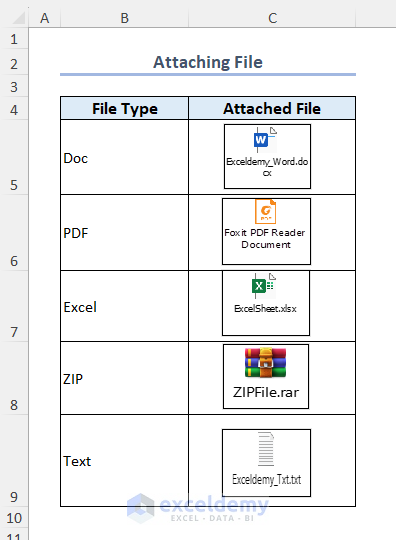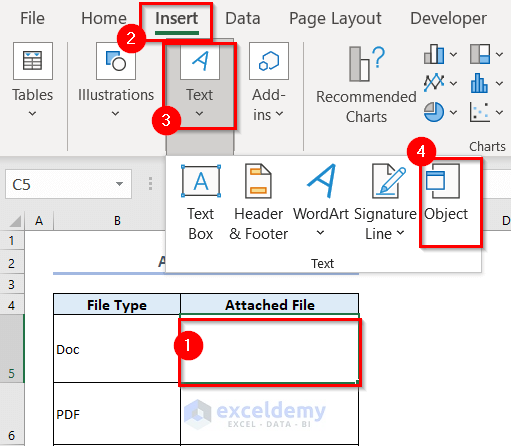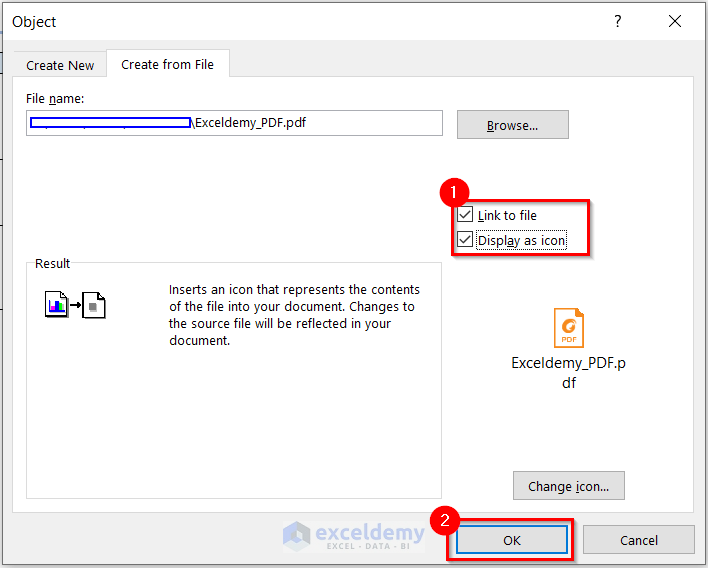How to Attach File in Excel (4 Easy Methods)

Here’s an overview showing what types of files you can attach to a sheet. ⏷ When Do We Attach File in Excel?
⏷ How to Attach a File
⏵ Attach Existing File as Embedded Object
⏵ Create a New File for Attachment
⏵ Use Context Menu to Link a File from Computer Storage
⏵ Update Attached Files Automatically
⏷ Insert Image Files
⏷ Things to Remember
⏷ Frequently Asked Questions
⏷ Attach File in Excel: Knowledge Hub
What Is an Attachment in Excel?
Attaching files in Excel allows you to include extra documents or information. This simplifies the process of explaining the data in your worksheet and makes it more accessible for others to work with.
When to Attach a File in Excel?
- When making a budget plan and you need additional resources.
- For additional information, charts, reports, and money receipts. You can create a single PDF file including them. You can even store the images or tables in PDF format. Then you can attach this PDF file in a single workbook.
- You can attach files that contain research paper information. In this case, if you have all the source files together then you can give your best in the presentation.
- You will often need to attach reference files for your data.
How to Attach a File in Excel? (4 Easy Methods)
Method 1 – Attach an Existing File as an Embedded Object
- Select cell C5 where we will keep the file.
- Go to the Insert tab and choose Object.


Note: If you check the ‘Link to file‘ option, the attached file will be updated automatically if you change any information in the source file. If you don’t want any updates, then you need to uncheck this option.
- Adjust the size of the icon by dragging the cursor from the edge.

Note: You can also right-click on the inserted object >> from Context Menu >> go to Format Object >> Properties >> check Move and size with cells.
- Repeat the procedure to attach multiple files in Excel.

Method 2 – Create a New File and Attach It to Excel
- Select a cell.
- Go to the Insert tab, select Text, and choose Object.
- From the Object dialog box, go to Create New.
- In Object type, select the file type.
- Check Display as icon.
- Press OK.

- We have chosen the Microsoft PowerPoint Slide, so a new PowerPoint window appeared.
- Prepare your new file.
- Close the window and you will get this file in the cell.

- We have attached different types of files in the same way.

Note: In the Create New option, if you choose the Object type like PDF format, then you need to select an existing file from your PC. You can’t edit this type of file at the time of attachment. While adding an existing file in Excel, use Method 1.
Method 3 – Use the Context Menu to Link a File from Computer Storage
- Go to a blank cell.
- Right-click on it.
- From the Context Menu, choose Link.

Click the image to see a detailed view
- From the Insert Hyperlink dialog box, go to your target folder, select the file, and press OK.

- Then you will get the file link in your Excel sheet. By clicking the link, you can go to that file.

How to Insert Link into Shape:
- Go to a cell.
- From the Insert tab, go to Shapes and insert a shape.

- You can link the file to this shape from the context menu. Use the same steps we described above.

- You can click on the shape and get the file.
Note: This method will work if the links and Excel file are on the same PC. So, while sharing a file from one PC to another, you can’t use this method.
Method 4 – Attach Files in Excel and Get the Updated Version
- Select a cell.
- Go to the Insert tab, choose Text, and select Object.

- From the Object dialog box, go to Create from File and click on Browse.

- From the Browse window, select the file and click on Insert.


- You will get the attached files as linked objects.

- Every time you update anything in the source file, these attached files will also be updated automatically.
Note: The source files and the Excel file must be on the same PC. Otherwise, you won’t be able to open the attached files.
How to Insert Image Files in Excel?
- From the Insert tab, under Illustrations group, go to the Pictures drop-down, and select This Device.

- The Insert Picture dialog box will appear. Select your PNG or JPG file and press Insert.

- You’ll get the picture in your worksheet. You can move or resize it by dragging the cursor.

- Sometimes moving images in Excel may break links or remove them. In that case, you need to reinsert the picture.
Note: Excel can’t handle GIF or BMP files directly. So, you must convert them. However, converting images can be time-consuming and might reduce the quality.
Things to Remember
- If you want to share your Excel file along with these attachments, don’t check the Link to file option. For more information, you can see Method 1 or Method 2.
- While creating a link to the original file for attachment, if you move or delete the original file, embedded objects will vanish.
- If you insert large images, Excel can slow down.
Frequently Asked Questions
How do I insert a notepad file into Excel?
- Open workbook, select a cell, then from Insert tab, go to Text and select Object
- From the Object dialog box, select Create from File and click on Browse
- Select the Notepad(.txt) file in the Browse dialog box, check Display as icon and press OK.
Yes, you can follow the instructions above to attack a PDF like any other text file.
How do I send an attachment in Excel?
- Go to the File tab and select Share
- Upload your workbook in OneDrive, write the Email address, and press the Send button.
Practice Section
We’ve attached a simple dataset you can uses to test these methods.

Download the Practice Workbook























